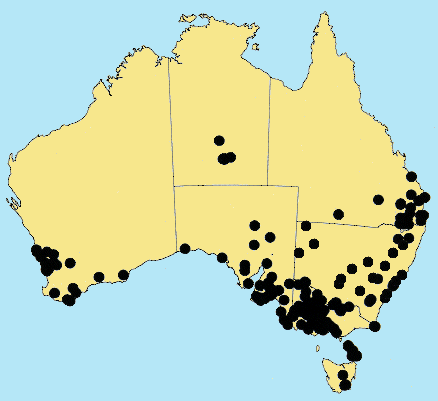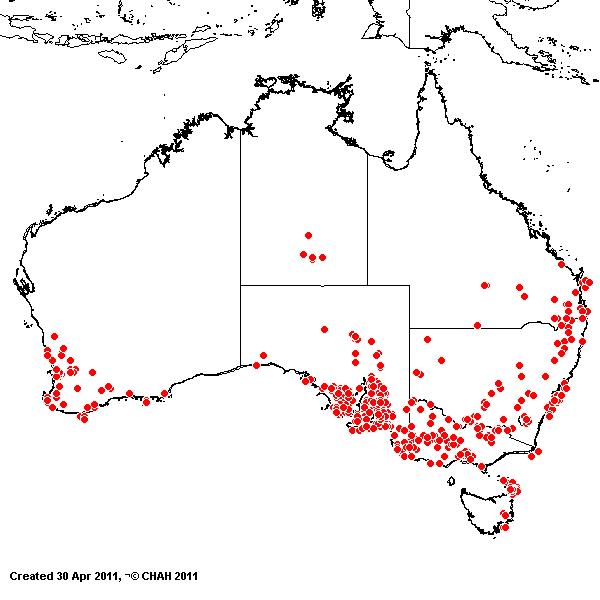Lolium rigidum* Gaud. Agrost. Helv. 1: 334 (1811). Classification. (GPWG 2001) : Subfamily Pooideae. Tribe Poeae.
Type of Basionym or Protologue Information: Europe: Switzerland: Augustae Praetoriae ad vias apricas 1809, Gaudin s.n. (HT: LAU).
Key references (books and floras): [1878] G.Bentham, Flora Australiensis 7 (664 as ?Festuca rigida), [1981] M.Lazarides in J.Jessop (ed)., Flora of Central Australia (430), [2002] D.Sharp & B.K.Simon, AusGrass, Grasses of Australia, [2002] J.Wheeler, N.Marchant & M.Lewington, Flora of the South West (422), [2006] J.Jessop, G.R.M.Dashorst, F.M.James, Grasses of South Australia (137), [2008] S.W.L.Jacobs, R.D.B.Walley & D.J.B.Wheeler, Grasses of New South Wales (297), [2009] A.Wilson (ed.). Flora of Australia, Vol 44A. Poaceae 2 (286), [1992] J.R.Wheeler et al, Flora of the Kimberley Region (288, Fig.38).
Illustrations: [1984] N.T.Burbidge. rev. S.W.L.Jacobs, Australian Grasses (193), [2006] J.Jessop, G.R.M.Dashorst, F.M.James, Grasses of South Australia (137, fig. 91), [2008] S.W.L.Jacobs, R.D.B.Whalley & D.J.B.Wheeler, Grasses of New South Wales, 4th edn (297), [2009]. A.Wilson (ed.), Flora of Australia 44A: Poaceae 2 (288, Fig 38), [2009]. A.Wilson (ed.), Flora of Australia 44A: Poaceae 2 (288, Fig 38).
Habit. Annual. Culms erect or geniculately ascending or decumbent, 15–100 cm tall, 2–4 -noded. Lateral branches simple or branched. Leaf-sheaths smooth or scaberulous. Leaf-sheath auricles absent, or present. Ligule an eciliate membrane, 1–1.5 mm long, truncate or obtuse. Leaf-blades 5–24 cm long, 0.5–5 mm wide. Leaf-blade surface smooth or scaberulous.
Inflorescence. Inflorescence solid, a spike. Racemes 1, straight or arcuate, 3–30 cm long, bearing 2–30 fertile spikelets on each.
Spikelets. Spikelets sessile. Fertile spikelets many flowered, with at least 2 fertile florets (2–8), comprising 2–8 fertile floret(s), with diminished florets at the apex, oblong, laterally compressed, 5–18 mm long.
Glumes. Glumes similar to fertile lemma in texture. Upper glume lanceolate or oblong or ovate, 4–20 mm long, coriaceous, without keels, 3–7 -nerved. Upper glume surface smooth or asperulous.
Florets. Fertile lemma 3.2–8.8 mm long, without keel, 3–5 -nerved. Lemma apex entire or erose, muticous or awned (rarely), 1 -awned. Median (principal) awn subapical, 0–3(–10) mm long overall. Lodicules present. Anthers 3. Grain 2.7–5.5 mm long.
Continental Distribution: Europe, Africa, Temperate Asia, Tropical Asia, Australasia, South America, and Antarctica.
Australian Distribution: Western Australia, Northern Territory, South Australia, Queensland, New South Wales, Victoria, Tasmania.
Western Australia: Drummond. Northern Territory: Central Australia South. South Australia: Lake Eyre, Nullabor, Flinders Ranges, Eastern, Eyre Peninsula, Northern Lofty, Murray, Yorke Peninsula, Southern Lofty, Kangaroo Island, South-eastern. Queensland: Darling Downs, Maranoa, Moreton, Port Curtis, Warrego, Wide Bay. New South Wales: North Coast, Central Coast, Central Tablelands, Southern Tablelands, Central-Western Slopes, South-Western Slopes, South-Western Plains, North Far Western Plains. Victoria: East Gippsland, Eastern Highlands, Gippsland Plain, Lowan Mallee, Midlands, Murray Mallee, Riverina, Volcanic Plain, Wannon, Wimmera. Tasmania: Furneaux Group, East Coast.
Notes. Cultivated widely in Australia as a pasture grass, but has become the major grass weed of field crops in southern Australia, see Kloot (1983).
Kloot recognises maritime forms morphologically very close to L. loliaceum. His diagnostic characters are: the glume c. equal to the spikelet; the spikelet c. linear; the glume acutely angled to the rachis at maturity; and the stem commonly pigmented.
Introduced. Also on Lord Howe Is. Southern Europe, N Africa, throughout Mediterranean region and Middle East to SW Asia; introduced in many parts of the world including southern Africa, North America and South America. Fields, roadsides, waste places, rocky hillsides, sandy areas. Flowers Aug.-Dec. Fruits Dec.- ?.



